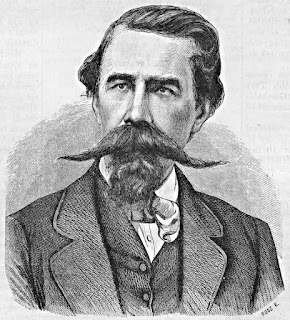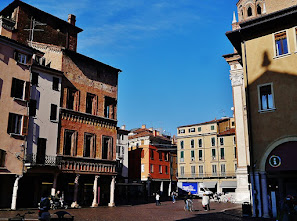Hungarian General married Napoleon’s beautiful great niece
.jpg) |
| Türr switched sides after witnessing Austrian cruelty against Italian troops |
The bridegroom was Stefano Türr - Istvan Türr in Hungarian - a soldier, revolutionary, canal architect and engineer, who is remembered in Italy for the role he played in the battle for the country’s unification.
Türr took a major part in the Expedition of the Thousand and was promoted to General, commanding Italian troops as they moved north from Sicily to Salerno. He was appointed Governor of Salerno by Garibaldi. Victor Emanuel II made him an aide de camp and entrusted him with sensitive diplomatic matters.
The bride was Adelina Bonaparte Wyse, who was a cousin of Napoleon III of France and granddaughter of Lucien Bonaparte, Napoleon I’s brother.
Türr had been accepted into the Austrian Army at the age of 17, but while stationed in Lombardy in 1848 had witnessed the cruel reprisals taken against rebellious Italians at Monza and changed his loyalties.
In 1849 he crossed a bridge over the Ticino river and joined the Piedmont side. He was placed in charge of other Hungarian soldiers who had deserted and led them during the First Italian War of Independence..jpg) |
| Türr married Adelina Bonaparte at a ceremony in Mantua |
During the Crimean War he raised a force of Hungarian exiles to fight against Russia. When he was sent to an area occupied by Austria, he was arrested, court martialled and sentenced to death. There were strong British protests, even involving Queen Victoria, and instead the Austrians banished him from their territory perpetually. Türr returned to Italy to fight in the Second Italian war of Independence and joined Garibaldi’s volunteer unit. He was dubbed the ‘Fearless Hungarian’ after chasing the Austrians near Brescia and being badly wounded.
Türr’s wife, Adelina, was the daughter of Princess Maria Letizia Bonaparte, the daughter of Napoleon’s brother, Lucien. Her legal father was Sir Thomas Wyse, the British Minister to Athens, but Princess Maria Letizia had previously separated from him and she was really fathered by Captain Studholme John Hodgson, her mother’s lover.Also in 1861, Adelina’s sister, Laetitia Marie, married Urbano Rattazzi, who served as Italian prime minister during the 1860s.
 |
| Türr was alongside Garibaldi as he launched his Expedition of the Thousand in 1860 |
Victor Emmanuel of Savoy had been declared King of the newly unified Italy in 1861 by the first Italian parliament, which had also named Rome as the capital of the new kingdom, even though they had still not gained control of the city.
A French garrison had remained in Rome on the orders of Napoleon III in support of Pope Pius IX, to appease fervent French Catholics.
But in 1870, after the outbreak of the Franco-Prussian war, Napoleon III had to withdraw many of his troops. Crack infantry soldiers from Piedmont led by General Raffaele Cadorna seized their chance and after a brief bombardment entered Rome through a breach in the Aurelian Walls near Porta Pia. Victor Emanuel II was able to take up residence in the Quirinale Palace, Italy was declared officially united and the Risorgimento was finally over.
Victor Emanuel II had previously written to the Pope offering a proposal that would have allowed the Italian army to enter Rome peacefully, but the pope had rejected this.
Pope Pius IX and his successors refused to recognise the right of Italian Kings to reign over what had been formerly known as the Papal States. It was not until the Lateran Treaty of 1929 that ‘the Roman question’ was settled by establishing Vatican City as an independent state.
In 1862, Türr acquired a villa in Pallanza with a garden facing Lake Maggiore. He and his wife Adelina became popular with the local people, Türr helping labourers with donations and becoming honorary president of the Società Operaia di Pallanza, while Adelina visited children in the local orphanages. Türr and Adelina had one son, Raoul, who was born in 1865. They enjoyed long holidays at their villa, often recorded in the local newspaper, which praised Adelina’s beauty.
In the 1870s Türr became a peace activist, regularly attending Peace Congresses and saying he now detested war.
 |
| The Piazza Mantegna is at the Renaissance heart of Mantua, where the couple were married |
Mantua, where Türr married Adelina, is an atmospheric old city in Lombardy, to the southeast of Milan. In the Renaissance heart of Mantua is Piazza Mantegna, where the 15th century Basilica of Sant’Andrea houses the tomb of the artist, Andrea Mantegna. The church was originally built to accommodate the large number of pilgrims who came to Mantua to see a precious relic, an ampoule containing what were believed to be drops of Christ’s blood mixed with earth. This was claimed to have been collected at the site of his crucifixion by a Roman soldier. The highlight of the city is the Renaissance Palazzo Ducale, the seat of the Gonzaga family between 1328 and 1707. The Camera degli Sposi is decorated with frescoes by Andrea Mantegna, depicting the life of Ludovico Gonzaga and his family in the 15th century. The beautiful backgrounds of imaginary cities and ruins reflect Mantegna’s love of classical architecture.
Türr bought a villa at Pallanza on the shores of Lake Maggiore in Piedmont as a holiday home for himself and his wife. It had been built in the 1850s by Bernardino Branca, the inventor of Fernet Branca, with gardens facing the lake. The family spent long holidays there, but after Türr was allowed to return to Hungary, they visited less and he sold the villa in 1876. It is now called Villa Rusconi Clerici. Türr returned to visit Pallanza many times afterwards and in 1888, when he became a naturalised Italian, it was recorded on the document that he lived in Pallanza.
Also on this day:
1887: The birth of politician Giovanni Gronchi
1890: The birth of fashion designer Elsa Schiaparelli
1930: The birth of holocaust survivor Liliana Segre
1960: Historic victory at Rome Olympics


.jpg)
.jpg)




.jpg)


